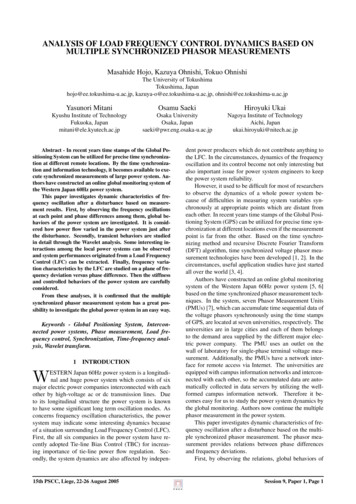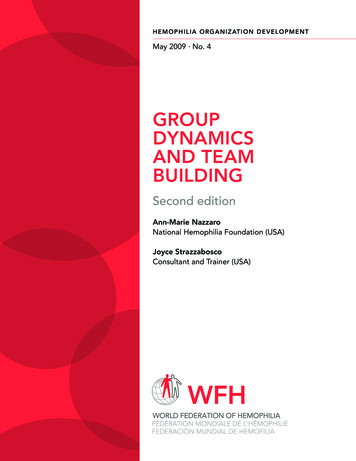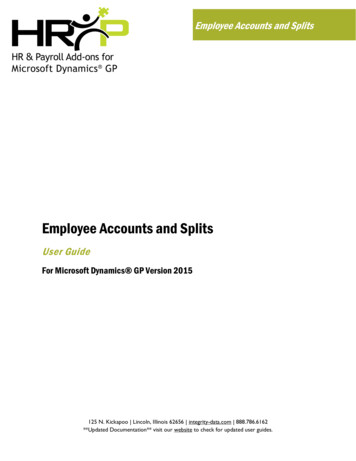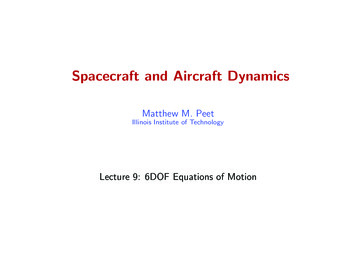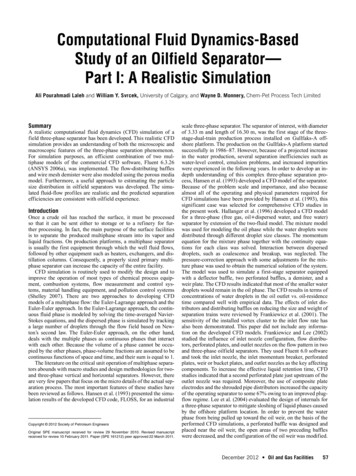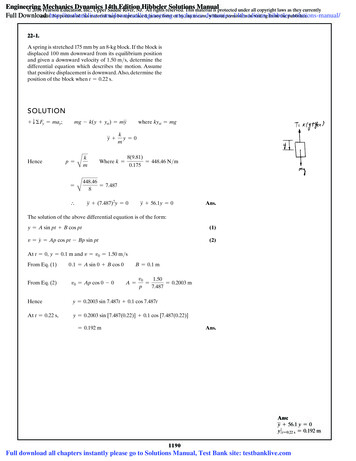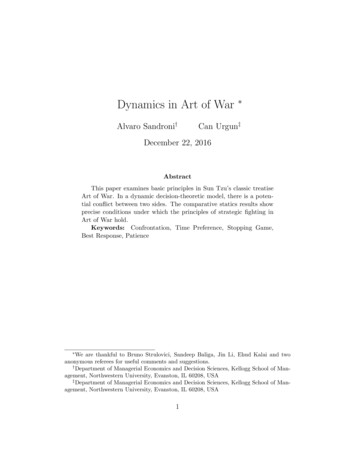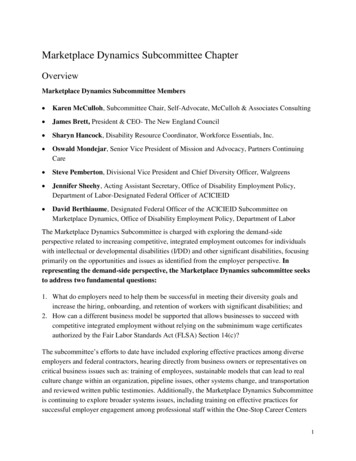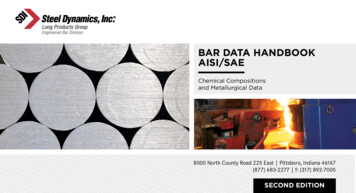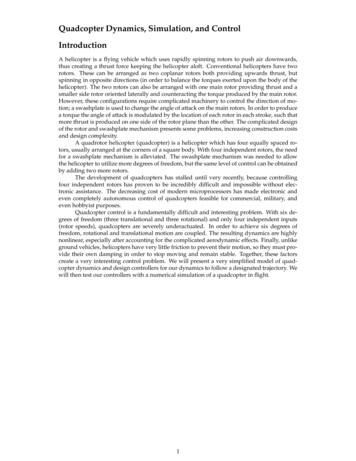
Transcription
Quadcopter Dynamics, Simulation, and ControlIntroductionA helicopter is a flying vehicle which uses rapidly spinning rotors to push air downwards,thus creating a thrust force keeping the helicopter aloft. Conventional helicopters have tworotors. These can be arranged as two coplanar rotors both providing upwards thrust, butspinning in opposite directions (in order to balance the torques exerted upon the body of thehelicopter). The two rotors can also be arranged with one main rotor providing thrust and asmaller side rotor oriented laterally and counteracting the torque produced by the main rotor.However, these configurations require complicated machinery to control the direction of motion; a swashplate is used to change the angle of attack on the main rotors. In order to producea torque the angle of attack is modulated by the location of each rotor in each stroke, such thatmore thrust is produced on one side of the rotor plane than the other. The complicated designof the rotor and swashplate mechanism presents some problems, increasing construction costsand design complexity.A quadrotor helicopter (quadcopter) is a helicopter which has four equally spaced rotors, usually arranged at the corners of a square body. With four independent rotors, the needfor a swashplate mechanism is alleviated. The swashplate mechanism was needed to allowthe helicopter to utilize more degrees of freedom, but the same level of control can be obtainedby adding two more rotors.The development of quadcopters has stalled until very recently, because controllingfour independent rotors has proven to be incredibly difficult and impossible without electronic assistance. The decreasing cost of modern microprocessors has made electronic andeven completely autonomous control of quadcopters feasible for commercial, military, andeven hobbyist purposes.Quadcopter control is a fundamentally difficult and interesting problem. With six degrees of freedom (three translational and three rotational) and only four independent inputs(rotor speeds), quadcopters are severely underactuated. In order to achieve six degrees offreedom, rotational and translational motion are coupled. The resulting dynamics are highlynonlinear, especially after accounting for the complicated aerodynamic effects. Finally, unlikeground vehicles, helicopters have very little friction to prevent their motion, so they must provide their own damping in order to stop moving and remain stable. Together, these factorscreate a very interesting control problem. We will present a very simplified model of quadcopter dynamics and design controllers for our dynamics to follow a designated trajectory. Wewill then test our controllers with a numerical simulation of a quadcopter in flight.1
Quadcopter DynamicsWe will start deriving quadcopter dynamics by introducing the two frames in which will operate. The inertial frame is defined by the ground, with gravity pointing in the negative zdirection. The body frame is defined by the orientation of the quadcopter, with the rotor axespointing in the positive z direction and the arms pointing in the x and y directions.Quadcopter Body Frame and Inertial FrameKinematicsBefore delving into the physics of quadcopter motion, let us formalize the kinematics in thebody and inertial frames. We define the position and velocity of the quadcopter in the inertialframe as x ( x, y, z) T and ẋ ( ẋ, ẏ, ż) T , respectively. Similarly, we define the roll, pitch, andyaw angles in the body frame as θ (φ, θ, ψ) T , with corresponding angular velocities equalto θ̇ (φ̇, θ̇, ψ̇) T . However, note that the angular velocity vector ω 6 θ̇. The angular velocityis a vector pointing along the axis of rotation, while θ̇ is just the time derivative of yaw, pitch,and roll. In order to convert these angular velocities into the angular velocity vector, we canuse the following relation: 10 sθω 0 cφ cθ sφ θ̇0 sφ cθ cφwhere ω is the angular velocity vector in the body frame.We can relate the body and inertial frame by a rotation matrix R which goes from thebody frame to the inertial frame. This matrix is derived by using the ZYZ Euler angle conventions and successively “undoing” the yaw, pitch, and roll. cφ cψ cθ sφ sψ cψ sφ cφ cθ sψ sθ sψR cθ cψ sφ cφ sψ cφ cθ cψ sφ sψ cψ sθ sφ sθcφ sθcθFor a given vector v in the body frame, the corresponding vector is given by R v in the inertialframe.PhysicsIn order to properly model the dynamics of the system, we need an understanding of thephysical properties that govern it. We will begin with a description of the motors being usedfor our quadcopter, and then use energy considerations to derive the forces and thrusts thatthese motors produce on the entire quadcopter. All motors on the quadcopter are identical, sowe can analyze a single one without loss of generality. Note that adjacent propellers, however,are oriented opposite each other; if a propeller is spinning “clockwise”, then the two adjacentones will be spinning “counter-clockwise”, so that torques are balanced if all propellers arespinning at the same rate.2
MotorsBrushless motors are used for all quadcopter applications. For our electric motors, the torqueproduced is given byτ Kt ( I I0 )where τ is the motor torque, I is the input current, I0 is the current when there is no load onthe motor, and Kt is the torque proportionality constant. The voltage across the motor is thesum of the back-EMF and some resistive loss:V IRm Kv ωwhere V is the voltage drop across the motor, Rm is the motor resistance, ω is the angularvelocity of the motor, and Kv is a proportionality constant (indicating back-EMF generatedper RPM). We can use this description of our motor to calculate the power it consumes. Thepower is(τ Kt I0 )(Kt I0 Rm τRm Kt Kv ω )P IV Kt 2For the purposes of our simple model, we will assume a negligible motor resistance. Then, thepower becomes proportional to the angular velocity:P (τ Kt I0 )Kv ωKtFurther simplifying our model, we assume that Kt I0 τ. This is not altogether unreasonable, since I0 is the current when there is no load, and is thus rather small. In practice, thisapproximation holds well enough. Thus, we obtain our final, simplified equation for power:P Kvτω.KtForcesThe power is used to keep the quadcopter aloft. By conservation of energy, we know thatthe energy the motor expends in a given time period is equal to the force generated on thepropeller times the distance that the air it displaces moves (P · d t F · d x). Equivalently, thepower is equal to the thrust times the air velocity (P F dd xt ).P TvhWe assume vehicle speeds are low, so vh is the air velocity when hovering. We also assumethat the free stream velocity, v , is zero (the air in the surrounding environment is stationaryrelative to the quadcopter). Momentum theory gives us the equation for hover velocity as afunction of thrust,sTvh 2ρAwhere ρ is the density of the surrounding air and A is the area swept out by the rotor. Usingour simplified equation for power, we can then write3P KvKv KτT2.τω Tω pKtKt2ρANote that in the general case, τ r F; in this case, the torque is proportional to the thrust Tby some constant ratio Kτ determined by the blade configuration and parameters. Solving forthe thrust magnitude T, we obtain that thrust is proportional to the square of angular velocityof the motor:!2pKv Kτ 2ρAT ω kω 2Kt3
where k is some appropriately dimensioned constant. Summing over all the motors, we findthat the total thrust on the quadcopter (in the body frame) is given by 04TB Ti k 0 .i 1 ωi 2In addition to the thrust force, we will model friction as a force proportional to thelinear velocity in each direction. This is a highly simplified view of fluid friction, but will besufficient for our modeling and simulation. Our global drag forces will be modeled by anadditional force term k d ẋFD k d ẏ k d żIf additional precision is desired, the constant k d can be separated into three separate frictionconstants, one for each direction of motion. If we were to do this, we would want to modelfriction in the body frame rather than the inertial frame.TorquesNow that we have computed the forces on the quadcopter, we would also like to compute thetorques. Each rotor contributes some torque about the body z axis. This torque is the torquerequired to keep the propeller spinning and providing thrust; it creates the instantaneousangular acceleration and overcomes the frictional drag forces. The drag equation from fluiddynamics gives us the frictional force:FD 1ρCD Av2 .2where ρ is the surrounding fluid density, A is the reference area (propeller cross-section, notarea swept out by the propeller), and CD is a dimensionless constant. This, while only accuratein some in some cases, is good enough for our purposes. This implies that the torque due todrag is given by11τD RρCD Av2 RρCD A(ωR)2 bω 222where ω is the angular velocity of the propeller, R is the radius of the propeller, and b is someappropriately dimensioned constant. Note that we’ve assumed that all the force is applied atthe tip of the propeller, which is certainly inaccurate; however, the only result that matters forour purposes is that the drag torque is proportional to the square of the angular velocity. Wecan then write the complete torque about the z axis for the ith motor:τz bω 2 I M ω̇where I M is the moment of inertia about the motor z axis, ω̇ is the angular acceleration ofthe propeller, and b is our drag coefficient. Note that in steady state flight (i.e. not takeoffor landing), ω̇ 0, since most of the time the propellers will be maintaining a constant (oralmost constant) thrust and won’t be accelerating. Thus, we ignore this term, simplifying theentire expression toτz ( 1)i 1 bωi 2 .where the ( 1)i 1 term is positive for the ith propeller if the propeller is spinning clockwiseand negative if it is spinning counterclockwise. The total torque about the z axis is given bythe sum of all the torques from each propeller: τψ b ω1 2 ω2 2 ω3 2 ω4 2The roll and pitch torques are derived from standard mechanics. We can arbitrarily choose thei 1 and i 3 motors to be on the roll axis, soτφ r T L(kω1 2 kω3 2 ) Lk(ω1 2 ω3 2 )4
Correspondingly, the pitch torque is given by a similar expressionτθ Lk (ω2 2 ω4 2 )where L is the distance from the center of the quadcopter to any of the propellers. All together,we find that the torques in the body frame are Lk (ω1 2 ω3 2 ) τB Lk (ω2 2 ω4 2 ) 2222b ω1 ω2 ω3 ω4The model we’ve derived so far is highly simplified. We ignore a multitude of advancedeffects that contribute to the highly nonlinear dynamics of a quadcopter. We ignore rotationaldrag forces (our rotational velocities are relatively low), blade flapping (deformation of propeller blades due to high velocities and flexible materials), surrounding fluid velocities (wind),etc. With that said, we now have all the parts necessary to write out the dynamics of our quadcopter.Equations of MotionIn the inertial frame, the acceleration of the quadcopter is due to thrust, gravity, and linearfriction. We can obtain the thrust vector in the inertial frame by using our rotation matrix R tomap the thrust vector from the body frame to the inertial frame. Thus, the linear motion canbe summarized as 0m ẍ 0 RTB FD mgwhere x is the position of the quadcopter, g is the acceleration due to gravity, FD is the dragforce, and TB is the thrust vector in the body frame.While it is convenient to have the linear equations of motion in the inertial frame, therotational equations of motion are useful to us in the body frame, so that we can expressrotations about the center of the quadcopter instead of about our inertial center. We derive therotational equations of motion from Euler’s equations for rigid body dynamics. Expressed invector form, Euler’s equations are written asI ω̇ ω ( Iω ) τwhere ω is the angular velocity vector, I is the inertia matrix, and τ is a vector of externaltorques. We can rewrite this as ω̇xω̇ ω̇y I 1 (τ ω ( Iω )) .ω̇zWe can model our quadcopter as two thin uniform rods crossed at the origin with a point mass(motor) at the end of each. With this in mind, it’s clear that the symmetries result in a diagonalinertia matrix of the form Ixx 00I 0 Iyy 0 .00 IzzTherefore, we obtain our final result for the body frame rotational equations of motion Iyy Izz ωωyzτφ Ixx 1I Izz xxIxx ω̇ τθ Iyy 1 Iyy ωx ωz 1I Ixxyyτψ IzzIzz ω x ωy5
SimulationNow that we have complete equations of motion describing the dynamics of the system, wecan create a simulation environment in which to test and view the results of various inputs andcontrollers. Although more advanced methods are available, we can quickly write a simulatorwhich utilizes Euler’s method for solving differential equations to evolve the system state. InMATLAB, this simulator would be written as follows.12345% Simulation times, in seconds.start time 0;end time 10;dt 0.005;times start time:dt:end time;678% Number of points in the simulation.N numel(times);910111213% Initial simulation state.x [0; 0; 10];xdot zeros(3, 1);theta zeros(3, 1);1415161718% Simulate some disturbance in the angular velocity.% The magnitude of the deviation is in radians / second.deviation 100;thetadot deg2rad(2 * deviation * rand(3, 1) - deviation);1920212223% Step through the simulation, updating the state.for t times% Take input from our controller.i input(t);24omega thetadot2omega(thetadot, theta);2526% Compute linear and angular accelerations.a acceleration(i, theta, xdot, m, g, k, kd);omegadot angular acceleration(i, omega, I, L, b, k);27282930omega omega dt * omegadot;thetadot omega2thetadot(omega, theta);theta theta dt * thetadot;xdot xdot dt * a;x x dt * xdot;313233343536endWe would then need functions to compute all of the physical forces and torques.12345% Compute thrust given current inputs and thrust coefficient.function T thrust(inputs, k)% Inputs are values for ωi 2T [0; 0; k * sum(inputs)];end67891011% Compute torques, given current inputs, length, drag coefficient, and thrust coefficifunction tau torques(inputs, L, b, k)% Inputs are values for ωi 2tau [L * k * (inputs(1) - inputs(3))6
L * k * (inputs(2) - inputs(4))b * (inputs(1) - inputs(2) inputs(3) - inputs(4))1213];1415end1617181920212223function a acceleration(inputs, angles, xdot, m, g, k, kd)gravity [0; 0; -g];R rotation(angles);T R * thrust(inputs, k);Fd -kd * xdot;a gravity 1 / m * T Fd;end2425262728function omegadot angular acceleration(inputs, omega, I, L, b, k)tau torques(inputs, L, b, k);omegaddot inv(I) * (tau - cross(omega, I * omega));endWe would also need values for all of our physical constants, a function to compute the rotationmatrix R, and functions to convert from an angular velocity vector ω to the derivatives of roll,pitch, and yaw and vice-versa. These are not shown. We can then draw the quadcopter in athree-dimensional visualization which is updated as the simulation is running.Quadcopter Simulation. Bars above each propeller represent, roughly, relative thrustmagnitudes.ControlThe purpose of deriving a mathematical model of a quadcopter is to assist in developing controllers for physical quadcopters. The inputs to our system consist of the angular velocitiesof each rotor, since all we can control is the voltages across the motors. Note that in our simplified model, we only use the square of the angular velocities, ωi 2 , and never the angularvelocity itself, ωi . For notational simplicity, let us introduce the inputs γi ωi 2 . Since wecan set ωi , we can clearly set γi as well. With this, we can write our system as a first orderdifferential equation in state space. Let x1 be the position in space of the quadcopter, x2 be thequadcopter linear velocity, x3 be the roll, pitch, and yaw angles, and x4 be the angular velocityvector. (Note that all of these are 3-vectors.) With these being our state, we can write the state7
space equations for the evolution of our state.x 1 x2 011x 2 0 RTB FDmm g 110 sθx 3 0 cφ cθ sφ x40 sφ cθ cφ Iyy Izz ωωyzτφ Ixx 1I Izz xxIxx x 4 τθ Iyy 1 Iyy ωx ωz 1I Ixxyyτψ IzzIzz ω x ωyNote that our inputs are not used in these equations directly. However, as we will see, we canchoose values for τ and T, and then solve for values of γi .PD ControlIn order to control the quadcopter, we will use a PD control, with a component proportionalto the error between our desired trajectory and the observed trajectory, and a component proportional to the derivative of the error. Our quadcopter will only have a gyro, so we will onlybe able to use the angle derivatives φ̇, θ̇, and ψ̇ in our controller; these measured values willgive us the derivative of our error, and their integral will provide us with the actual error. Wewould like to stabilize the helicopter in a horizontal position, so our desired velocities andangles will all be zero. Torques are related to our angular velocities by τ I θ̈, so we wouldlike to set the torques proportional to the output of our controller, with τ Iu(t). Thus, RT Ixx Kd φ̇ K p 0 φ̇d tτφ RT τθ Iyy Kd θ̇ K p 0 θ̇d t RτψT Izz Kd ψ̇ K p 0 ψ̇d tWe have previously derived the relationship between torque and our inputs, so we know that RT Ixx Kd φ̇ K p 0 φ̇d tLk (γ1 γ3 ) RT Lk (γ2 γ4 )τB Iyy Kd θ̇ K p 0 θ̇d t RTb (γ1 γ2 γ3 γ4 ) Izz Kd ψ̇ K p 0 ψ̇d tThis gives us a set of three equations with four unknowns. We can constrain this by enforcingthe constraint that our inputs must keep the quadcopter aloft:T mg.Note that this equation ignores the fact that the thrust will not be pointed directly up. Thiswill limit the applicability of our controller, but should not cause major problems for smalldeviations from stability. If we had a way of determining the current angle accurately, wecould compensate. If our gyro is precise enough, we can integrate the values obtained fromthe gyro to get the angles θ and φ. In this case, we can calculate the thrust necessary to keepthe quadcopter aloft by projecting the thrust mg onto the inertial z axis. We find thatTproj mg cos θ cos φTherefore, with a precise angle measurement, we can instead enforce the requirement that thethrust be equal tomgT cos θ cos φ8
in which case the component of the thrust pointing along the positive z axis will be equal tomg. We know that the thrust is proportional to a weighted sum of the inputs:T mg k γi cos θ cos φ γi mgk cos θ cos φWith this extra constraint, we have a set of four linear equations with four unknowns γi . Wecan then solve for each γi , and obtain the following input values:mg4k cos θ cos φmgγ2 4k cos θ cos φmgγ3 4k cos θ cos φmgγ4 4k cos θ cos φγ1 2beφ Ixx eψ Izz kL4bkLeψ Izzeθ Iyy 4b2kL 2beφ Ixx eψ Izz kL 4bkLeψ Izzeθ Iyy 4b2kL This is a complete specification for our PD controller. We can simulate this controllerusing our simulation environment. The controller drives the angular velocities and angles tozero.Left: Angular velocities. Right: angular displacements. φ, θ, ψ are coded as red, green, andblue.However, note that the angles are not completely driven to zero. The average steady stateerror (error after 10 seconds of simulation) is approximately 0.3 . This is a common problemwith using PD controllers for mechanical systems, and can be partially alleviated with a PIDcontroller, as we will discuss in the next section.In addition, note that since we are only controlling angular velocities, our positionsand linear velocities do not converge to zero. However, the z position will remain constant,9
because we have constrained the total vertical thrust to be such that it keeps the quadcopterperfectly aloft, without ascending or descending. However, this is really nothing more than acuriosity. With the limited sensing that we have available to us, there is nothing we can do tocontrol the linear position and velocity of the quadcopter. While in theory we could computethe linear velocities and positions from the angular velocities, in practice the values will beso noisy as to be completely useless. Thus, we will restrict ourselves to just stabilizing thequadcopter angle and angular velocity. (Traditionally, navigation is done by a human, andstabilization is there simply to make control easier for the human operator.)10
We have implemented this PD control for use in our simulation. The controller is implemented as a function which is given some state (corresponding to controller state, not systemstate) and the sensor inputs, and must compute the inputs γi and the updated state. The codefor a PD control follows.123456% Compute system inputs and updated state.% Note that input [γ1 , . . ., γ4 ]function [input, state] pd controller(state, thetadot)% Controller gains, tuned by hand and intuition.Kd 4;Kp 3;7% Initialize the integral if necessary.if isfield(state, ’integral’)params.integral zeros(3, 1);end89101112% Compute total thrusttotal state.m * state.g / state.k / (cos(state.integral(1)) * cos(state.integral131415% Compute errorse Kd * thetadot Kp * params.integral;161718% Solve for the inputs, γiinput error2inputs(params, accels, total);192021% Update the stateparams.integral params.integral params.dt .* thetadot;222324endPID ControlPD controllers are nice in their simplicity and ease of implementation, but they are often inadequate for controlling mechanical systems. Especially in the presence of noise and disturbances,PD controllers will often lead to steady state error. A PID control is a PD control with anotherterm added, which is proportional to the integral of the process variable. Adding an integralterm causes any remaining steady-state error to build up and enact a change, so a PID controller should be able to track our trajectory (and stabilize the quadcopter) with a significantlysmaller steady-state error. The equations remain identical to the ones presented in the PD case,but with an additional term in the error:eφ Kd φ̇ K peθ Kd θ̇ K peψ Kd ψ̇ K pZ T0Z T0Z T0φ̇d t Kiθ̇d t KiZ TZ T00Z TZ Tψ̇d t Ki00φ̇d td tθ̇d td tZ TZ T00ψ̇d td tHowever, PID controls come with their own shortcomings. One problem that commonly occurs with a PID control is known as integral windup.11
In some cases, integral wind-up can cause lengthy oscillations instead of settling. In othercases, wind-up may actually cause the system to become unstable, instead of taking longer toreach a steady state.If there is a large disturbance in the process variable, this large disturbance is integrated overtime, becoming a still larger control signal (due to the integral term). However, even once thesystem stabilizes, the integral is still large, thus causing the controller to overshoot its target.It may then begin a series of dieing down oscillations, become unstable, or simply take anincredibly long time to reach a steady state. In order to avoid this, we disable the integralfunction until we reach something close to the steady state. Once we are in a controllableregion near the desired steady state, we turn on the integral function, which pushes the systemtowards a low steady-state error.12
With a properly implemented PID, we achieve an error of approximately 0.06 after 10seconds.We have implemented this PID control for use in simulation, in the same way as with thePD controller shown earlier. Note that there is an additional parameter to tune in a PID. Thedisturbances used for all the test cases are identical, shown to compare the controllers.1234567% Compute system inputs and updated state.% Note that input [γ1 , . . ., γ4 ]function [input, state] pid controller(state, thetadot)% Controller gains, tuned by hand and intuition.Kd 4;Kp 3;Ki 5.5;8910111213% Initialize the integral if necessary.if isfield(state, ’integral’)params.integral zeros(3, 1);params.integral2 zeros(3, 1);end1415161718% Prevent wind-upif max(abs(params.integral2)) 0.01params.integral2(:) 0;end192021% Compute total thrusttotal state.m * state.g / state.k / (cos(state.integral(1)) * cos(state.integral2223% Compute errors13
e Kd * thetadot Kp * params.integral - Ki * params.integral2;2425% Solve for the inputs, γiinput error2inputs(params, accels, total);262728% Update the stateparams.integral params.integral params.dt .* thetadot;params.integral2 params.integral2 params.dt .* params.integral;29303132end14
Automatic PID TuningAlthough PID control has the potential to perform very well, it turns out that the quality of thecontroller is highly dependent on the gain parameters. Tuning the parameters by hand maybe quite difficult, as the ratios of the parameters is as important as the magnitudes of the parameters themselves; often, tuning parameters requires detailed knowledge of the system andan understanding of the conditions in which the PID control will be used. The parameters wechose previously were tuned by hand for good performance, simply by running simulationswith many possibly disturbances and parameter values, and choosing something that workedreasonably well. This method is clearly suboptimal, not only because it can be very difficultand labor-intensive (and sometimes more or less impossible) but also because the resultinggains are not in any way guaranteed to be optimal or even close to optimal.Ideally, we would be able to use an algorithm to analyze a system and output the “optimal” PID gains, for some reasonable definition of optimal. This problem has been studiedin depth, and many methods have been proposed. Many of these methods require detailedknowledge of the system being modeled, and some rely on properties of the system, such asstability or linearity. The method we will use for choosing our PID parameters is a methodknown as extremum seeking.Extremum seeking works exactly as the name implies. We define the “optimal” set ofparameters as some vector θ (K p , Ki , Kd ) which minimizes some cost function J ( θ ). In ourcase, we would like to define a cost function that penalizes high error and error over extendeddurations of time. One candidate cost function is given byJ ( θ ) 1t f toZ tft0e(t, θ )2 d twhere e(t, θ ) is the error in following some reference trajectory with some initial disturbanceusing a set of parameters θ. Suppose we were able to somehow compute the gradient ofthis cost function, J ( θ ). In that case, we could iteratively improve our parameter vector bydefining a parameter update rule θ (k 1) θ (k) α J ( θ )where θ (k) is the parameter vector after k iterations and α is some step size which dictates howmuch we adjust our parameter vector at each step of the iteration. As k , the cost functionJ ( θ ) will approach a local minimum in the space of PID parameters.The question remains as to how we can estimate J ( θ ). By definition, J ( θ ), J (θ ) J ( θ ),J (θ ) . K p Ki KdWe know how to compute J ( θ ). Using this, we can approximate the derivative with respect toany of the gains numerically, simply by computing J ( θ δ · ûK ) J ( θ δ · ûK )J (θ ) K2δwhere ûK is the unit vector in the K direction. As δ 0, this approximation becomes better.Using this approximation, we can minimize our cost function and achieve locally optimal PIDparameters. We can start with randomly initialized positive weights, disturb the system insome set manner, evaluate J ( θ ) by simulating the system for different PID parameters, andthen compute the gradient. Then, using the method of gradient descent, we can iterativelyoprtimize our gains until we have some form of convergence.The gradient descent method does, however, have several problems. First of all, although it finds a local minimum, that minimum is only guaranteed to be a local minimum- there may be other minima which are better global minima. In order to avoid choosingsuboptimal local minima in the cost function, we repeat our optimization several times, andchoose the best result. We initialize our PID parameters randomly, so each time we run theoptimization we will get a different result. In addition, instead of choosing disturbance andthen optimizing the response to that disturbance, we use several random disturbances at each15
iteration and use the average response to compute costs and gradients. This ensures that ourparameters are general and not optimized for a specific disturbance. In addition, we vary thestep size and the number of disturbances to try per iteration, in order to increase the sensitivity of our results as our iteration continues. We stop iterations when we detect a steady state,which we do by computing a linear regression on the most recent costs and iterating until theslope is statistically indistinguishable from zero using a 99% confidence interval.Using our quadcopter simulation, we can define a function that computes the cost for agiven set of PID parameters.123function J cost(theta)% Create a controller using the given gains.control controller(’pid’, theta(1), theta(2), theta(3));4% Perform a simulation.data simulate(control);567R tf12% Compute the integral, t t0 e ( t ) dtt0ft0 0;tf 1;J 1/(tf - t0) * sum(data.theta(data.t t0 & data.t tf) .ˆ 2) * data.dt;89101112endWe can use this function to approximate a derivative with respect to a gain:1234% Compute derivative with respect to first parameter.delta 0.01;var [1, 0, 0];derivative (cost(theta delta * var) - cost(theta - delta * var)) / (2 * delta);We can then use our gradient descent method (with all modifications described above) tominimize the cost function and obtain a good set of PID parameters. We can verify that ourtuning method is working
the motor, and Kt is the torque proportionality constant. The voltage across the motor is the sum of the back-EMF and some resistive loss: V IRm Kvw where V is the voltage drop across the motor, Rm is the motor resistance, w is the angular velocity of the motor, and Kv is a proporti


